African pre-coinage metal currency takes many unusual forms. One type, commonly called “throwing axe currency,” takes the form of a blunt, ceremonial hatchet or axe. Another type takes the form of a curved knife and is often called “throwing knife currency,” and these objects may actually have served a functional purpose as a weapon of warfare and/or as an agricultural tool; they also served a secondary purpose as part of a wedding dowry or as a valued funerary offering.
Still other types of currency took the form of broad, flat “hoe currency,” and the original forms of these objects may have served as functional hoe tools. These eventually became valued primarily for their symbolic shape, and they served as a funerary offering or a unit of monetary value for trade. Later versions of “hoe currency” were made very large and flat, with crescent-shaped cutout sides, and these would have been too fragile for actual use as hoes. Nevertheless, while their purpose was primarily symbolic, they were used as currency only when money was absolutely required to make a trade.
Ingot currency is yet another form of African metal currency, and this, too, actually served as a unit of currency. However, ingots took the convenient form of a tajere, an iron “blank” that could be forged into a tool or other iron object as needed — and that could be forged back into an ingot when desired.
Anchor currency is among the most unusual of African metal currency, not only for its large form, but also because of its manufacture: Rather than being smelted and forged like most iron objects, anchor currency was stamped and bent into an anchor shape. Also unusual about anchor currency is that, unlike other currencies, this piece needed to maintain is formal integrity to keep its value; if the spear-like tips broke off or became damaged, then these objects no longer held monetary value and could no longer be utilized as currency.
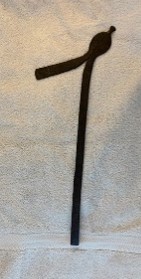
Flattened Metal Throwing Axe Currency
Chamba culture
20th century
Iron, L. 46 cm x W. 5 mm x H. 15 cm
Missouri State University collection #2018.1.82
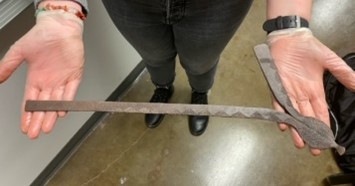
Flattened Metal Throwing Axe Currency
Chamba culture
20th century
Iron, L. 46 cm x W. 5 mm x H. 15 cm
Missouri State University collection #2018.1.82
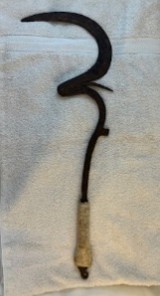
Mafa culture
20th century
Iron, fur, and rawhide, L. 56.5 cm. x W. 2 cm x H. 18.5 cm
Missouri State University collection #2018.1.71
Iron and leather, L. 62.5 cm. x W. 1.5 cm x H. 20.5 cm
Missouri State University collection #2018.1.72
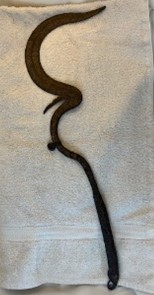
Mafa culture
20th century
Iron, fur, and rawhide, L. 56.5 cm. x W. 2 cm x H. 18.5 cm
Missouri State University collection #2018.1.71
Iron and leather, L. 62.5 cm. x W. 1.5 cm x H. 20.5 cm
Missouri State University collection #2018.1.72
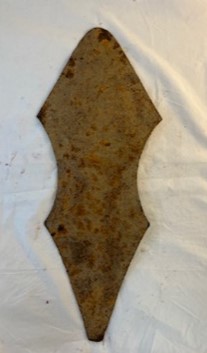
Mfunte culture
20th century
Iron, L. 22.5 cm x W. 5 mm x H. 55.5 cm
Missouri State University collection #2018.1.70a
Iron, L. 20 cm x W. 1 cm x H. 57.5 cm
Missouri State University collection #2018.1.70b
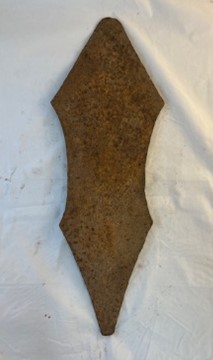
Mfunte culture
20th century
Iron, L. 22.5 cm x W. 5 mm x H. 55.5 cm
Missouri State University collection #2018.1.70a
Iron, L. 20 cm x W. 1 cm x H. 57.5 cm
Missouri State University collection #2018.1.70b
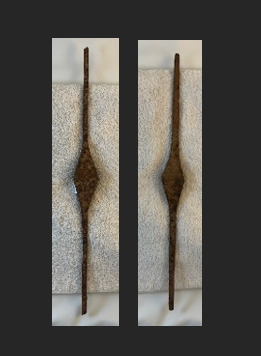
Two Pieces of Tajere Ingot Currency
Fulbe culture
20th century
Iron, L. 4 cm x W. 1.5 cm x H. 46.5 cm
Missouri State University collection #2018.1.83a
Iron, L. 3.5 cm x W. 1 cm x H. 32 cm
Missouri State University collection #2018.1.83b

Two Pieces of Tajere Ingot Currency
Fulbe culture
20th century
Iron, L. 4 cm x W. 1.5 cm x H. 46.5 cm
Missouri State University collection #2018.1.83a
Iron, L. 3.5 cm x W. 1 cm x H. 32 cm
Missouri State University collection #2018.1.83b
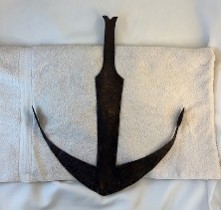
Mandjang Anchor Currency
Kwele culture
20th century
Iron, L. 37.5 cm x W. 2 cm x H. 49.5 cm
Missouri State University collection #2018.1.99
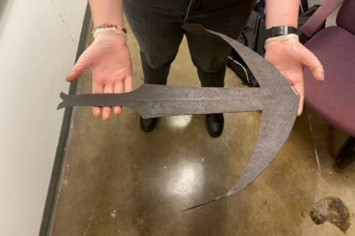
Mandjang Anchor Currency
Kwele culture
20th century
Iron, L. 37.5 cm x W. 2 cm x H. 49.5 cm
Missouri State University collection #2018.1.99
For more information, you may contact the researcher(s) noted in the title of this exhibit entry, or Dr. Billie Follensbee, the professor of the course, at BillieFollensbee@MissouriState.edu
